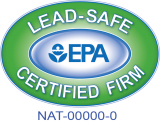When Should Siding Be Replaced?

For most homeowners, replacing siding is not at the top of their to-do list. In fact, many homeowners don’t even think of about their siding unless there is major visible damage. Many homes look beautiful for years, and hopefully even decades, when they have had good quality siding installed by professional contractors. Unfortunately, there is always the potential for trouble. Siding does eventually wear out. It can crack or break. At some point, it may begin to leak, causing other major (and probably expensive) damage.
So, the question is this: how does a homeowner know when their home needs new siding? What are the signs that signal it is time to consider replacement siding?
While it’s true that your siding can last for decades, the siding will slowly weather and deteriorate over time. Often, the deterioration is so gradual that most homeowners do not even detect the changes until they are severe. The first thing to do is take a walk around your house at a distance of about 25 feet. At that distance, you will be able to see the obvious signs of wear and tear or weather related damage. You should also do a close up inspection of the siding, looking for smaller potential issues. If you do have noticeable damage, be sure to hire an experienced siding contractor to do a complete replacement as soon as possible. It is important to prevent further problems that occur when water leaks in behind the siding. No one wants to handle other water related issues, such as mold and mildew.
The tips listed below will help you accurately assess the condition of the siding materials to determine whether or not it’s time to replace your siding:
Frequent Painting Is Needed
If a home needs to be repainted every five or six years, chances are pretty good that something is wrong with the current siding. Good quality siding typically maintains its shape and color for at least ten years. Paint that is cracking, chipping, or peeling is a sign that there is a major problem that needs to be addressed.
Holes, Dents and Dings
Aluminum and vinyl siding will take a pounding over the course of time. Holes, dents, dings, cracks and scratches can be caused by insects or flying debris in a storm. If insects have gotten into or through the siding, they can cause some major problems. Even small holes are a concern because they can allow rain and snow to get behind the planks where moisture can linger.
Warping or Rotting Planks
Warped or rotting planks are not always noticeable unless a thorough visual inspection is competed. Completing a regular siding inspection, looking specifically for warped siding, rotting planks and other damage will help determine if there is any unseen water damage.
Have a fairly sharp object available, such as a screwdriver, when completing your siding inspection. Poke under any warped siding planks to determine how solid the under layer is. If the layer under the siding has become soft or begun to rot, it is definitely time to schedule a siding replacement project.
Mold, Mildew or Fungus
Looking for mold, mildew and fungus is an important part of any siding inspection. Any type of growth, such as mold, mildew or fungus on the siding, especially at or near seams in the siding, may indicate that water is penetrating and being held inside the wall. Wood planks can become waterlogged over years of extreme weather; the resulting mold and mildew is very hard to permanently remove. While not all signs of mold, mildew or fungus on home siding should be a cause for alarm, it is always important to investigate further. To avoid water-related damage going forward, consider replacing current siding with vinyl or fiber cement siding; those siding materials can stand up to extreme wet weather without damage.
Faded Siding
Severely faded siding is definitely a concern when inspecting your home’s siding. Of course, we all know that nothing lasts forever and even siding has a specific life expectancy. In most cases, siding is made to keep its color for only as long as its life expectancy rating. When siding is so old that the color is noticeably faded, it is a good indication that the waterproofing may no long be effective. Faded color is not definitive proof that the siding is no longer viable, but it is a good indication that it is time to look for other signs, including potential water damage.
High Heating and Cooling Bills
When a home’s heating or cooling costs skyrocket, that may also be a sign that siding replacement is necessary. Of course, there are a number of things to check out first, before assuming that the current siding is the issue at hand. When energy bills substantially increase, be sure to rule out a bad or leaking roof or inadequate attic insulation. Energy costs that are not in line with those of neighbors with similar structures may be a sign that something is seriously wrong with a home’s exterior wall insulation.
Inside Issues
It may not be obvious to most homeowners, but peeling paint or wallpaper that is pulling away from a wall inside of a home can be an important sign of faulty siding. Damaged or poor quality siding allows moisture to trickle underneath the siding; once there, it can soak through wallboard, causing major damage to the interior walls of a home.
After a thorough inspection of your siding, you may determine that it is time to get rid of the old and install a replacement. Protecting your home from potential damage from the elements (rain, wind, snow) or from insects taking up residence in your siding, is the top reason for siding replacement. Another reason, however, may simply be about aesthetics. Your home’s siding may still be in good shape, but perhaps you don’t like the look or would prefer a different color or style. Of course, you want your home to look its best, and new siding can be a great boost to a home’s curb appeal, especially when it comes time to sell.
No matter what the reason, if it is time to tackle a siding replacement project, talk to the experienced siding professionals at Allied Siding and Windows about the job. Cutting and fitting siding so that it is waterproof and windproof is a must, therefore you will want to hire a knowledgeable contractor who will assess your needs, discuss available siding materials, including vinyl and fiber cement siding, and guarantee quality and satisfaction. Allied Siding and Windows uses only top name, industry-leading siding. Using only high quality products, in conjunction with their stringent construction and production practices, ensures an optimum level of performance, results, and satisfaction for every customer. Call Allied Siding and Windows today for additional information.
Call Allied Siding & Windows Today! | |
|---|---|
HOUSTON | |
AUSTIN | DALLAS |











